 The Two Micron All Sky Survey at IPAC
The Two Micron All Sky Survey at IPAC
![]()
 The Two Micron All Sky Survey at IPAC
The Two Micron All Sky Survey at IPAC
|
|
|
 The Crab Nebula, or Messier 1, is one of the most spectacular and intensively
studied objects in the sky. It is the remnant of a supernova in AD 1054,
observed as a "guest star" by the Chinese in today's constellation Taurus.
It is among the brightest remnants across a broad wavelength spectrum.
The Crab Nebula is probably the best-known synchrotron emission nebula. The
synchrotron is what is primarily seen in the 2MASS image. In addition,the
central power-law source, the Crab pulsar, is photo-exciting line
emission. The gas in the nebula has not yet mixed with the interstellar
medium, and so study of the line-emitting gas gives us insight on the
progenitor star. The blue-green
[Fe II] 1.644 µm emission is excited in the optically thick filaments in
the Crab Nebula by the power-law photoionization source within; H2
seen as K-band emission in the filaments could not normally survive in these
nebular conditions and must have formed early in the
remnant's expansion when densities were higher
(Graham, Wright, & Longmore 1990, ApJ, 352, 172).
(Field size 8.2´ × 10.2´. Image size 298 kb.)
The Crab Nebula, or Messier 1, is one of the most spectacular and intensively
studied objects in the sky. It is the remnant of a supernova in AD 1054,
observed as a "guest star" by the Chinese in today's constellation Taurus.
It is among the brightest remnants across a broad wavelength spectrum.
The Crab Nebula is probably the best-known synchrotron emission nebula. The
synchrotron is what is primarily seen in the 2MASS image. In addition,the
central power-law source, the Crab pulsar, is photo-exciting line
emission. The gas in the nebula has not yet mixed with the interstellar
medium, and so study of the line-emitting gas gives us insight on the
progenitor star. The blue-green
[Fe II] 1.644 µm emission is excited in the optically thick filaments in
the Crab Nebula by the power-law photoionization source within; H2
seen as K-band emission in the filaments could not normally survive in these
nebular conditions and must have formed early in the
remnant's expansion when densities were higher
(Graham, Wright, & Longmore 1990, ApJ, 352, 172).
(Field size 8.2´ × 10.2´. Image size 298 kb.)
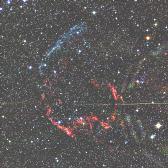 Atlas Image Mosaic of the intermediate-age Galactic supernova remnant
IC 443,
which is at a distance of about 1.5 kpc. What can be seen over this large area
are two regions of near-infrared emission from the remnant. The bright bluish
arc to the northeast appears to be line emission from excited iron in these
remnant filaments, bright in the J band (Rho et al., in preparation). Along
the south, from east to west, is the interaction of the remnant with the nearby
molecular cloud. IC 443 offers a unique laboratory for studying such
interactions. The supernova shock is exciting 2.12-micron H_2 molecular line
emission, very bright in the Ks band (Richter, Graham, & Wright 1995, ApJ,
454, 277). Some H_2 emission is also seen weakly to the north. The emission
from the partially dissociative "J-type" shock-cloud interaction is complex and
clumpy. The overall structure of the remnant, as seen by 2MASS, follows both
the radio and X-ray emission contours, showing that the radiation in all these
wavelength regimes seems to arise from the same regions in the remnant.
Analysis of this large-area 2MASS mosaic will provide important insight into
the interaction of supernova remnants with their immediate environment, and
therefore into the probable nature of the supernova remnant's stellar
progenitor. These data are part of the 2MASS Spring 1999 Incremental data
release. Image mosaic by E. Kopan (IPAC).
(Field size 0.83° × 0.97°. Image size 3.4 Mb!)
Atlas Image Mosaic of the intermediate-age Galactic supernova remnant
IC 443,
which is at a distance of about 1.5 kpc. What can be seen over this large area
are two regions of near-infrared emission from the remnant. The bright bluish
arc to the northeast appears to be line emission from excited iron in these
remnant filaments, bright in the J band (Rho et al., in preparation). Along
the south, from east to west, is the interaction of the remnant with the nearby
molecular cloud. IC 443 offers a unique laboratory for studying such
interactions. The supernova shock is exciting 2.12-micron H_2 molecular line
emission, very bright in the Ks band (Richter, Graham, & Wright 1995, ApJ,
454, 277). Some H_2 emission is also seen weakly to the north. The emission
from the partially dissociative "J-type" shock-cloud interaction is complex and
clumpy. The overall structure of the remnant, as seen by 2MASS, follows both
the radio and X-ray emission contours, showing that the radiation in all these
wavelength regimes seems to arise from the same regions in the remnant.
Analysis of this large-area 2MASS mosaic will provide important insight into
the interaction of supernova remnants with their immediate environment, and
therefore into the probable nature of the supernova remnant's stellar
progenitor. These data are part of the 2MASS Spring 1999 Incremental data
release. Image mosaic by E. Kopan (IPAC).
(Field size 0.83° × 0.97°. Image size 3.4 Mb!)
 Atlas Image mosaic of the source Cassiopeia A.
Cas A, for short, has a faint, ghostly shell-like
appearance in the 2MASS image, with several brighter filaments.
Cas A was first discovered in the late '40s by radio astronomers as the
brightest radio object in the sky at 1 GHz. It is now understood to be
possibly the youngest supernova remnant in the Milky Way Galaxy! No
clear records of the supernova's appearance in the optical sky exist
historically, as is the case for the Crab Nebula
(the Chinese 'guest star' of
1054 AD), but it has been linked to a 6th magnitude star, no longer visible
near the constellation Cassiopeia, in a catalogue by Flamsteed from 1680 AD.
The inference is that Cas A
may have been a subluminous supernova, resulting from the explosion of a
Wolf-Rayet
star; this picture is motivated by the chemical composition of the
various fast and slow moving knots in the remnant, which, along with analyses
of the radio and X-ray emission, are consistent with
the explosion of a very massive star with very little hydrogen in its
envelope. Cas A is at a distance of ~3.4 kpc (11,000 ly); at only ~2°
from the Galactic Plane, it is seen behind ~5-6 mag of visual
extinction (Hurford & Fesen 1996, ApJ, 469, 246).
Most of the energy from Cas A is, in fact, radiated in the infrared.
The mid-infrared emission, as seen by the recent ISO satellite, is mostly
thermal dust emission, with some line emission, and is associated primarily
with the fast-moving knots, suggesting that dust is condensing out in the
expanding supernova ejecta (Lagage et al. 1996, A&A, 315, L273).
Image mosaic by S. Van Dyk (IPAC).
(Field size 6.0´ × 6.0´. Image size 192 kb.)
Atlas Image mosaic of the source Cassiopeia A.
Cas A, for short, has a faint, ghostly shell-like
appearance in the 2MASS image, with several brighter filaments.
Cas A was first discovered in the late '40s by radio astronomers as the
brightest radio object in the sky at 1 GHz. It is now understood to be
possibly the youngest supernova remnant in the Milky Way Galaxy! No
clear records of the supernova's appearance in the optical sky exist
historically, as is the case for the Crab Nebula
(the Chinese 'guest star' of
1054 AD), but it has been linked to a 6th magnitude star, no longer visible
near the constellation Cassiopeia, in a catalogue by Flamsteed from 1680 AD.
The inference is that Cas A
may have been a subluminous supernova, resulting from the explosion of a
Wolf-Rayet
star; this picture is motivated by the chemical composition of the
various fast and slow moving knots in the remnant, which, along with analyses
of the radio and X-ray emission, are consistent with
the explosion of a very massive star with very little hydrogen in its
envelope. Cas A is at a distance of ~3.4 kpc (11,000 ly); at only ~2°
from the Galactic Plane, it is seen behind ~5-6 mag of visual
extinction (Hurford & Fesen 1996, ApJ, 469, 246).
Most of the energy from Cas A is, in fact, radiated in the infrared.
The mid-infrared emission, as seen by the recent ISO satellite, is mostly
thermal dust emission, with some line emission, and is associated primarily
with the fast-moving knots, suggesting that dust is condensing out in the
expanding supernova ejecta (Lagage et al. 1996, A&A, 315, L273).
Image mosaic by S. Van Dyk (IPAC).
(Field size 6.0´ × 6.0´. Image size 192 kb.)
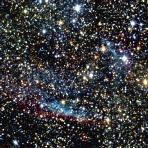 Atlas Image mosaic of RCW 103, a young supernova
remnant (SNR) in the Milky Way, less than 1° from the Plane of the Galaxy.
As a result, the interstellar extinction along the line of sight to the SNR is
about 4.5 visual magnitudes (Oliva, Moorwood, & Danziger 1990, A&A, 240, 453).
In the near-infrared 2MASS image, one sees filamentary emission of a
bluish-green color, forming what appears to be an incomplete shell, with some
fainter emission interior to this partial shell, surrounded by reddish
emission, particularly in the southeast. The red color is from molecular
hydrogen (H2) line emission at 2.12 µm. The blue-green color
is [FeII] (forbidden singly-ionized iron) line emission at 1.64 µm.
Oliva et al. (1999, A&A, 341, L75) find that the morphology of the [Fe II]
emission identically traces out the optical line emission, and that the
H2 emission arises from a region outside the SNR, as seen at
optical, radio, and X-ray wavelengths. The H2 emission is from
molecular gas around the SNR which has not yet been reached by the fast-moving
(~1200 km/s) shock wave, but is most likely a dense molecular cloud heated by
the X-rays being emitted by the shock.
The remnant likely has an age of only about 1000 years, arising from the
explosion of a massive star. The nature of the progenitor star can be inferred
from the presence of a 69-millisecond-period radio and X-ray pulsar near
RCW 103 (Kaspi et al. 1998, ApJ, 503, L161; Torii et al. 1998, ApJ, 496, L207);
pulsars are rapidly rotating neutron stars, and neutron stars are the remnant
collapsed cores of stars more massive than about 8 times the mass of our Sun.
The picture that emerges is of a massive star not unexpectedly ending its life
explosively within its natal gas cloud. Image mosaic by S. Van Dyk (IPAC).
(Field size 11.0´ × 11.0´. Image size 499 kb.)
Atlas Image mosaic of RCW 103, a young supernova
remnant (SNR) in the Milky Way, less than 1° from the Plane of the Galaxy.
As a result, the interstellar extinction along the line of sight to the SNR is
about 4.5 visual magnitudes (Oliva, Moorwood, & Danziger 1990, A&A, 240, 453).
In the near-infrared 2MASS image, one sees filamentary emission of a
bluish-green color, forming what appears to be an incomplete shell, with some
fainter emission interior to this partial shell, surrounded by reddish
emission, particularly in the southeast. The red color is from molecular
hydrogen (H2) line emission at 2.12 µm. The blue-green color
is [FeII] (forbidden singly-ionized iron) line emission at 1.64 µm.
Oliva et al. (1999, A&A, 341, L75) find that the morphology of the [Fe II]
emission identically traces out the optical line emission, and that the
H2 emission arises from a region outside the SNR, as seen at
optical, radio, and X-ray wavelengths. The H2 emission is from
molecular gas around the SNR which has not yet been reached by the fast-moving
(~1200 km/s) shock wave, but is most likely a dense molecular cloud heated by
the X-rays being emitted by the shock.
The remnant likely has an age of only about 1000 years, arising from the
explosion of a massive star. The nature of the progenitor star can be inferred
from the presence of a 69-millisecond-period radio and X-ray pulsar near
RCW 103 (Kaspi et al. 1998, ApJ, 503, L161; Torii et al. 1998, ApJ, 496, L207);
pulsars are rapidly rotating neutron stars, and neutron stars are the remnant
collapsed cores of stars more massive than about 8 times the mass of our Sun.
The picture that emerges is of a massive star not unexpectedly ending its life
explosively within its natal gas cloud. Image mosaic by S. Van Dyk (IPAC).
(Field size 11.0´ × 11.0´. Image size 499 kb.)
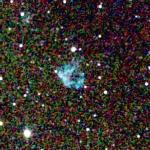 Atlas Image of the supernova remnant (SNR) N49 in the Large Magellanic
Cloud (LMC). This appears to be the first near-infrared image of this SNR.
The optical, X-ray, near-infrared and radio
morphology for N49 all are in general agreement, with an incomplete shell
covering nearly 1´ in diameter.
Emission due to the hydrogen Paschen beta line and lines of forbidden
singly-ionized iron ([Fe II]) in the J and H bands likely dominate what we
see. Strong Ks-band emission, as in the
case of the SNR IC 443 in our Galaxy, due
to molecular hydrogen (H2) line emission excited by
shock-molecular cloud interaction, is surprising lacking, given the apparent
interaction with an extended dense cloud to the southeast, as deduced by the
optical (Vancura et al. 1992, ApJ, 394, 158) and X-ray (Hughes et al. 1998,
ApJ, 505, 732) observations. N49 is also intriguing, with its possible
association with the soft gamma-ray repeater SGR 0525-66 near the SNR's
northern edge, however, this association has not yet been firmly established.
SGRs are linked to isolated neutron stars, so if the association holds, this
is further possible evidence of a massive stellar progenitor for this SNR.
These data are included in the Second Incremental Release!
(Field size 5.0´ × 5.0´. Image size 144 kb.)
Atlas Image of the supernova remnant (SNR) N49 in the Large Magellanic
Cloud (LMC). This appears to be the first near-infrared image of this SNR.
The optical, X-ray, near-infrared and radio
morphology for N49 all are in general agreement, with an incomplete shell
covering nearly 1´ in diameter.
Emission due to the hydrogen Paschen beta line and lines of forbidden
singly-ionized iron ([Fe II]) in the J and H bands likely dominate what we
see. Strong Ks-band emission, as in the
case of the SNR IC 443 in our Galaxy, due
to molecular hydrogen (H2) line emission excited by
shock-molecular cloud interaction, is surprising lacking, given the apparent
interaction with an extended dense cloud to the southeast, as deduced by the
optical (Vancura et al. 1992, ApJ, 394, 158) and X-ray (Hughes et al. 1998,
ApJ, 505, 732) observations. N49 is also intriguing, with its possible
association with the soft gamma-ray repeater SGR 0525-66 near the SNR's
northern edge, however, this association has not yet been firmly established.
SGRs are linked to isolated neutron stars, so if the association holds, this
is further possible evidence of a massive stellar progenitor for this SNR.
These data are included in the Second Incremental Release!
(Field size 5.0´ × 5.0´. Image size 144 kb.)
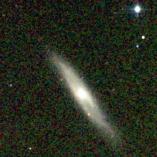 Atlas Image of the spiral
galaxy NGC 3877, taken as part of routine operations on 1998 Dec 24 UT
at the 2MASS Northern Facility on Mt. Hopkins, AZ. What is most interesting
about this image is that the supernova SN 1998S was caught in the act
in the near-infrared, about
49´´ southwest of the galaxy's nucleus, along the spiral arm! SN
1998S (Li, Filippenko, & Moran 1998, IAUC 6829) is of type II-"narrow"
(Schlegel 1990, MNRAS, 244, 269). Supernovae of this subtype tend
to show broad emission lines of hydrogen (and other elements) in their optical
spectra (thus, the Type II classification), due to the rapid expansion of the
hydrogen-rich supernova ejecta. But, atop the broad lines are narrow
lines, likely due to emission from the interaction region of the SN shock with
slower-moving very dense circumstellar matter lost by the progenitor star in
the late stages of its evolution prior to explosion. SN 1998S emits strongly
in the near-infrared, primarily due to the broad hydrogen recombination lines,
but also due to the first and second overtone bands of CO (the carbon monoxide
molecule) in the H and Ks bands (Gerardy et al. 1998, BAAS, 30,
1324). Gerardy et al. find from their near-IR spectra a CO overabundance of
~2 and a temperature in the CO-forming region of 4000 to 4500 K. Their
spectra may indicate that molecule formation is common in Type II supernovae;
this is important, since molecular emission can be a strong coolant and a
first step toward dust formation.
The SN had Ks magnitude 13.16, indicating a possible brightening
in this and the other near-IR bands since observations by others on 1998 Nov
10 UT (Garnavich et al. 1998, IAUC 7058), which already indicated a large
infrared excess had developed then.
(Field size 5.8´ × 5.8´. Image size 167 kb.)
Atlas Image of the spiral
galaxy NGC 3877, taken as part of routine operations on 1998 Dec 24 UT
at the 2MASS Northern Facility on Mt. Hopkins, AZ. What is most interesting
about this image is that the supernova SN 1998S was caught in the act
in the near-infrared, about
49´´ southwest of the galaxy's nucleus, along the spiral arm! SN
1998S (Li, Filippenko, & Moran 1998, IAUC 6829) is of type II-"narrow"
(Schlegel 1990, MNRAS, 244, 269). Supernovae of this subtype tend
to show broad emission lines of hydrogen (and other elements) in their optical
spectra (thus, the Type II classification), due to the rapid expansion of the
hydrogen-rich supernova ejecta. But, atop the broad lines are narrow
lines, likely due to emission from the interaction region of the SN shock with
slower-moving very dense circumstellar matter lost by the progenitor star in
the late stages of its evolution prior to explosion. SN 1998S emits strongly
in the near-infrared, primarily due to the broad hydrogen recombination lines,
but also due to the first and second overtone bands of CO (the carbon monoxide
molecule) in the H and Ks bands (Gerardy et al. 1998, BAAS, 30,
1324). Gerardy et al. find from their near-IR spectra a CO overabundance of
~2 and a temperature in the CO-forming region of 4000 to 4500 K. Their
spectra may indicate that molecule formation is common in Type II supernovae;
this is important, since molecular emission can be a strong coolant and a
first step toward dust formation.
The SN had Ks magnitude 13.16, indicating a possible brightening
in this and the other near-IR bands since observations by others on 1998 Nov
10 UT (Garnavich et al. 1998, IAUC 7058), which already indicated a large
infrared excess had developed then.
(Field size 5.8´ × 5.8´. Image size 167 kb.)
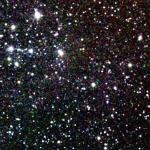 Atlas Image of the environment of Supernova
1987A in the Large Magellanic Cloud (LMC).
SN 1987A was the closest supernova, or exploding star, to us, at ~50 kpc
(163,000 light years), since Kepler's in 1604 (distance < 20,000 light years),
which occurred in our own Milky Way Galaxy. SN 1987A is not actually
visible in the 2MASS image, since it is quite faint and also difficult to
resolve from its two blue neigboring stars, but its position is indicated by
the top of the white line on the image. At very high resolution in the
optical, the Hubble Space Telescope (HST) first revealed the amazing
ring structure around the supernova. From the 2MASS
color-color and
color-magnitude diagrams, we see that the environment of SN 1987A
consists of several different populations of stars. The colored lines on
the color-magnitude diagram roughly trace out the LMC populations: green,
the many, old (~14 Gyr) red giants; blue, the top of the hot main sequence; and
red, the young (~20 Myr), primarily red, supergiant stars. The latter group
are predominately from the large stellar association, Lucke-Hodge 90, near the
northeast corner of the image. Noticeably lacking are older and dust-obscured
asymptotic giant branch stars. The group of stars at J-Ks~0.4 are
stars in the Galactic foreground. SN 1987A is beginning to interact with the
rings, as seen in recent HST images,
and continues to be a wondrous object.
(Field size 8´ × 8´. Image size 291 kb.)
Atlas Image of the environment of Supernova
1987A in the Large Magellanic Cloud (LMC).
SN 1987A was the closest supernova, or exploding star, to us, at ~50 kpc
(163,000 light years), since Kepler's in 1604 (distance < 20,000 light years),
which occurred in our own Milky Way Galaxy. SN 1987A is not actually
visible in the 2MASS image, since it is quite faint and also difficult to
resolve from its two blue neigboring stars, but its position is indicated by
the top of the white line on the image. At very high resolution in the
optical, the Hubble Space Telescope (HST) first revealed the amazing
ring structure around the supernova. From the 2MASS
color-color and
color-magnitude diagrams, we see that the environment of SN 1987A
consists of several different populations of stars. The colored lines on
the color-magnitude diagram roughly trace out the LMC populations: green,
the many, old (~14 Gyr) red giants; blue, the top of the hot main sequence; and
red, the young (~20 Myr), primarily red, supergiant stars. The latter group
are predominately from the large stellar association, Lucke-Hodge 90, near the
northeast corner of the image. Noticeably lacking are older and dust-obscured
asymptotic giant branch stars. The group of stars at J-Ks~0.4 are
stars in the Galactic foreground. SN 1987A is beginning to interact with the
rings, as seen in recent HST images,
and continues to be a wondrous object.
(Field size 8´ × 8´. Image size 291 kb.)
Return to 2MASS Image Gallery Homepage